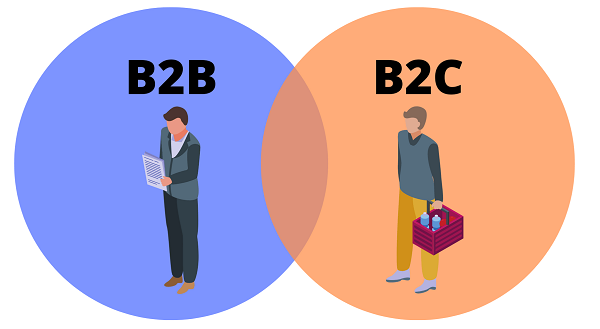What is B2B E-commerce? B2B (business-to-business) e-commerce refers to online transactions or electronic business processes between two companies. Unlike B2C (business-to-consumer) models, B2B involves sales between manufacturers, wholesalers, distributors, or other businesses rather than individual customers.
The rapid growth of digital transformation and the rise of e-commerce platforms have reshaped traditional B2B transactions, pushing them to online platforms where business customers expect seamless, digital purchasing experiences akin to what B2C customers enjoy.
Market Overview As of 2024, the global B2B e-commerce market is projected to surpass $20 trillion, accounting for more than 13% of the total B2B trade volume. The shift towards e-commerce is driven by several factors including the need for efficiency, cost savings, enhanced buyer experiences, and a growing demand for self-service tools.
Importance of B2B E-commerce in Today’s Market With an increasing number of businesses prioritizing convenience and digital solutions, B2B e-commerce is no longer a mere trend; it is a necessity for companies looking to remain competitive. Digitally native businesses and traditional suppliers alike must adopt online sales strategies to meet the evolving expectations of corporate buyers.
Key Differences Between B2B and B2C E-commerce

Complexity of Transactions B2B transactions are typically far more complex than B2C. The B2B sales process often involves multiple decision-makers, custom pricing, bulk orders, and negotiated terms, whereas B2C usually consists of single-user purchases with fixed prices and standardized terms.
Longer Sales Cycles In B2B, the sales cycle is often longer. Businesses conduct thorough research, compare suppliers, negotiate terms, and involve multiple departments before finalizing a purchase. This contrasts with B2C purchases, which are often more impulsive and shorter in duration.
Pricing Structures While B2C pricing is usually straightforward, B2B pricing can be highly variable. Discounts, tiered pricing, and bulk order incentives are common. Many B2B e-commerce platforms offer personalized pricing based on factors like customer loyalty, negotiated contracts, or purchase volumes.
Customer Relationships In B2B, maintaining long-term relationships is critical. Repeat purchases, customer loyalty, and ongoing partnerships are central to B2B success, while B2C often focuses on customer acquisition and one-time transactions.
Volume and Frequency of Orders B2B transactions usually involve large volumes, with recurring or contractual orders. In contrast, B2C transactions are typically smaller in volume and frequency, focusing more on individual purchases.
Benefits of B2B E-commerce for Businesses
1. Expanded Market Reach One of the most significant advantages of B2B e-commerce is its ability to reach a broader market. Unlike traditional business models that rely on geographical proximity, e-commerce allows businesses to target new national and global markets.
2. Enhanced Customer Experience Today’s B2B buyers expect an intuitive and seamless purchasing process. E-commerce platforms offer 24/7 availability, self-service portals, and mobile accessibility, which improves customer satisfaction and engagement.
3. Cost Efficiency Automation is a key feature of B2B e-commerce platforms. Automating routine processes like order management, invoicing, and inventory tracking reduces the need for manual labor, leading to significant cost savings.
4. Data-Driven Decision Making E-commerce platforms generate valuable data on customer behavior, purchase patterns, and sales trends. Companies can leverage this data to optimize pricing strategies, personalize marketing efforts, and improve inventory management.
5. Streamlined Operations B2B e-commerce platforms integrate with other business tools like Enterprise Resource Planning (ERP), Customer Relationship Management (CRM), and supply chain management systems, streamlining business operations from order processing to customer support.
Essential Features of a B2B E-commerce Platform
1. Custom Pricing and Discounts B2B businesses require flexible pricing models. A robust platform should offer custom price lists for different customer segments, volume-based discounts, and negotiated contract pricing.
2. Account Management Tools Unlike B2C platforms, B2B e-commerce requires multi-user accounts with varying roles and permissions. Account management features should allow companies to assign users different access levels for purchasing, viewing invoices, and approving orders.
3. Integration with ERP and CRM Systems A successful B2B platform needs to sync with existing business systems, including ERP, CRM, and supply chain tools. This ensures a seamless flow of information across departments, eliminating data silos and reducing manual work.
4. Quoting and Negotiation Capabilities B2B transactions often involve negotiations over pricing, terms, and delivery. E-commerce platforms should enable online quotes, negotiation tools, and the ability to convert approved quotes into orders.
5. Bulk Ordering and Quick Reordering Since B2B purchases often involve large quantities, the platform should allow for bulk ordering with features like saved order templates, product bundles, and quick reorder options for repeat purchases.
6. Detailed Product Information B2B buyers need comprehensive product information to make informed decisions. The platform should provide detailed product descriptions, specifications, datasheets, and customer reviews to aid the purchasing process.
7. Advanced Search and Navigation Given the size of B2B product catalogs, advanced search and filtering options are critical. Features like search by SKU, custom categories, and predictive search help buyers quickly find the products they need.
Strategies for Success in B2B E-commerce

1. Personalization at Scale B2B buyers expect a personalized experience, from tailored product recommendations to custom pricing. Use data analytics to segment customers based on their industry, purchasing behavior, or location, and deliver personalized offers and product suggestions.
2. Omnichannel Approach Integrating both online and offline sales channels is key to delivering a cohesive customer experience. Ensure that buyers can seamlessly transition from one channel to another, whether they are visiting your website, mobile app, or physical sales office.
3. Invest in a User-Friendly Interface User experience (UX) is just as important in B2B as it is in B2C. A poorly designed website can drive buyers away. Prioritize a simple, clean interface, mobile responsiveness, and fast loading times to ensure a seamless experience.
4. Content Marketing and SEO Leverage content marketing to attract, engage, and educate your audience. Create detailed product guides, case studies, whitepapers, and blog posts that address the pain points of your buyers. Additionally, optimize your content and website structure for search engines to drive organic traffic.
5. Customer Support and Self-Service B2B buyers often require support during the purchasing process, especially for complex products or large orders. Provide multiple support options including live chat, phone support, and self-service portals where customers can manage orders, track shipments, and access invoices.
6. Build Long-Term Relationships Relationship-building is crucial in B2B. Focus on maintaining strong, ongoing relationships by offering excellent after-sales support, regular communication, and loyalty programs that reward repeat purchases.
Common Challenges in B2B E-commerce
1. Complex Pricing Structures Managing diverse pricing structures for different customers or industries can be a logistical challenge. Ensuring that each customer sees the correct prices based on their contract, location, or volume requires a flexible and scalable platform.
2. Integration with Legacy Systems Many businesses struggle with integrating new e-commerce platforms with existing ERP, CRM, and other legacy systems. Poor integration can lead to data discrepancies, inefficiencies, and operational bottlenecks.
3. Adapting to Digital Transformation Traditional B2B businesses may struggle to adapt to a digital-first model. Moving from in-person sales to online interactions requires a significant cultural shift and investments in new technologies.
4. Providing a Seamless User Experience Because B2B transactions are often more complex than B2C, creating a seamless user experience can be challenging. The complexity of bulk ordering, quoting, and negotiation can lead to friction points if not properly managed.
5. Security and Compliance B2B e-commerce platforms handle sensitive data, including financial information, contracts, and personal details of company stakeholders. Ensuring that your platform is compliant with data protection regulations and secure from cyber threats is paramount.
Best Practices to Overcome B2B E-commerce Challenges
1. Automate Pricing and Contracts Utilize technology to automate pricing models and contract management. Dynamic pricing tools and smart contracts can help businesses manage complex pricing strategies more effectively, ensuring that every customer gets the correct price without manual intervention.
2. Focus on Seamless Integration When adopting a new e-commerce platform, prioritize solutions that offer robust APIs and integration capabilities with your existing systems. This will streamline operations and reduce friction between different parts of the business, from sales to finance.
3. Invest in Employee Training To effectively manage digital transformation, invest in training programs for your staff. This ensures that your team can fully leverage the features of your e-commerce platform and provide a better experience for customers.
4. Adopt a Customer-Centric Approach Ensure that your platform is designed with the end-user in mind. Regularly gather feedback from your customers and use that information to continuously improve your e-commerce experience.
5. Implement Strong Security Measures Invest in strong cybersecurity protocols and ensure that your platform is compliant with relevant regulations such as GDPR or CCPA. Use tools like SSL certificates, two-factor authentication, and data encryption to protect customer data.
Future Trends in B2B E-commerce

1. Artificial Intelligence and Machine Learning AI and machine learning will play an increasingly significant role in B2B e-commerce, from personalized product recommendations to dynamic pricing models and chatbots that assist in customer service.
2. Increased Use of Augmented Reality (AR) B2B companies are starting to use AR to offer virtual product demos, 3D visualizations, and remote troubleshooting services. AR allows customers to interact with products digitally before making purchasing decisions.
3. Blockchain for Transparency and Trust Blockchain technology is being explored in B2B e-commerce to enhance trust and transparency in the supply chain. Smart contracts, traceability, and fraud prevention are areas where blockchain could revolutionize B2B transactions.
4. Mobile Commerce As B2B buyers increasingly rely on mobile devices, B2B e-commerce platforms must optimize their mobile experiences. Expect to see more mobile-first platforms and applications designed specifically for B2B buyers on the go.
5. Sustainability and Ethical Sourcing Buyers are becoming more concerned about sustainability and ethical sourcing. B2B platforms that highlight eco-friendly practices and provide transparency around product sourcing and manufacturing will have a competitive edge.
Conclusion
B2B e-commerce is rapidly transforming the way businesses interact and conduct transactions. As companies adapt to digital-first approaches, the need for robust, flexible, and user-friendly e-commerce platforms becomes essential. Businesses that can successfully navigate the challenges of B2B e-commerce while embracing new technologies and trends will position themselves for long-term success.
This comprehensive guide has provided insights into the key differences between B2B and B2C, the features necessary for a B2B e-commerce platform, strategies for success, common challenges, and future trends. Embracing these strategies and staying ahead of trends can help companies unlock the full potential of B2B e-commerce.
Read Also
